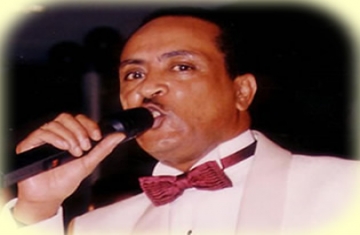 On April 19, 2009, Ethiopians lost the greatest popular musician the country has ever produced, the supremely gifted singer, Tilahun Gessesse. The following is a tribute
by Charles Sutton.
On April 19, 2009, Ethiopians lost the greatest popular musician the country has ever produced, the supremely gifted singer, Tilahun Gessesse. The following is a tribute
by Charles Sutton.
East Africa Forum
(Posted here with permission)
Introduction by Shlomo Bachrach
Charles Sutton — usually known as Charlie — came to Ethiopia with the Peace Corps in 1996. He was a musician, and even before he arrived, Charlie had discovered Ethiopian music through his Amharic language instructors. He describes the impact of that discovery, which directed his life toward a deep and lasting relationship with Ethiopia, its people — particularly musicians, and its language, in which his fluency and elegance continue to astonish.
Charlie needs only a brief introduction from me since he will provide the rest himself. His friends and acquaintances know Charlie to be a gracious, warm and generous man, thoughtful and polite to a fault. He is still a working musician both as a teacher and a performer. In his jazz, Charlie’s improvisations reveal the depth to which Ethiopia has entered his soul. In a recent recording, Charlie played masinko and sang, in Amharic, naturally, with two long-time Ethiopian musician friends. Characteristically, Charlie often directs the proceeds from his CD sales to the Institute for Ethiopian Studies or another deserving beneficiary.
This is the first of a three-part appreciation and reminisence by Charles Sutton about his friend, the supremely gifted singer, Tilahun Gessesse, who passed away on April 19, 2009 in Addis Ababa. All of Ethiopia, and music lovers around the world, are in mourning.
Shlomo Bachrach
Washington DC
Sutton’s Tribute to Tilahun Gessesse – Part II – Ye Muzika Metsihet
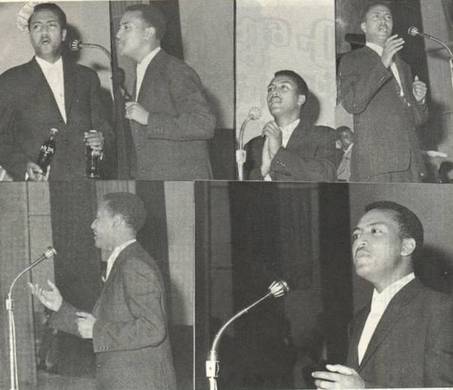
Part I of my tribute to Tilahun Gessesse concluded on a late summer evening in 1966, when staff Amharic teachers and I performed his beautiful song “Oo-oota Ayaskeffam” in a music show during Peace Corps training at the University of Utah. As I begin writing again on the 40th-day memorial of Tilahun’s death, I feel privileged to join you once more in commemorating this great, iconic singer. In Part II, I will attempt to thank Tilahun in a more personal way, by acknowledging how profoundly he affected me during the years I spent as a Peace Corps Volunteer–and musical performer–in Ethiopia . Perhaps I can best do this by inviting you to revisit with me a second musical event. It occurred almost exactly two years after the Utah show. The date was September 11, 1968 (Meskerem 1, 1961), and the occasion was the Grand New Year’s Music Festival at the Ambassador Theater in Addis Ababa .
It was early, a little past eleven o’clock in the morning, when I arrived outside the Theater on that long-ago New Year’s Day. Already there was a large, animated crowd of music fans clustered around the box office, basking in the warm spring sunshine as they waited to purchase their tickets for the annual marathon show that would begin at one in the afternoon and continue until late into the night. I paused for a moment near the main entrance to gaze at a large advertising poster on which I saw my name and photograph included along with those of Tilahun and other popular vocalists whose appearances were promised.
As I made my way through the throng toward the stage entrance at the rear of the building, a newspaper boy ran after me. Under one arm he clutched a large stack of orange-colored magazines.”Mister Charles! Mister Charles!” he cried. Music Magazine! Published today! Hot off the press! Limited edition just for the Festival! Great pictures and write-ups of Tilahun, Bizunesh Bekkele, Alemayehu Eshete–all the big stars! And you, Mister Charles! You! You are in it too! Look!” With a flourish, he opened a copy and held it up for my inspection.
“Mister Charles!” he continued. “This fantastic souvenir edition costs only one birr! Get yours now, before they are all gone! “I didn’t need any more persuading. Fishing in the single, narrow pocket of my suri, I extracted the few coins necessary to make up the price. By this time, we were surrounded by several more newsboys clamoring for me to buy their copies too. Leaving the sunlight, I escaped with my purchase through the stage door into the cavernous theater’s backstage gloom.
For the equivalent of U.S. 40 cents, Ye Muzika Metsihet (“Music Magazine”, as I have translated it; the text, except for a few English words added for effect to its advertisements, is entirely in Amharic) was undoubtedly one of the best bargains I have ever encountered. Much more than a playbill, the metsihet contains in its 70 pages detailed descriptions of all the contemporary artists, groups, musical directors, and technicians; magnificent photographs and collages; and thoughtful essays covering a variety of musical subjects. There is even a section devoted to English and American pop luminaries of the day like Tom Jones, Elvis Presley, and Ray Charles. The attractive cover of Music Magazine features a young, beautiful Asnakech Worku seated amidst spring flowers, plucking the strings of her krar.
All this was the work of Shawul Baminew, a presenter of popular music on Radio Ethiopia . Music Magazine was obviously a labor of love, which I doubt has been equaled before or since. Once inside the theater, I became so absorbed in the magazine–which today remains one of my most treasured possessions–that I almost missed my cue.
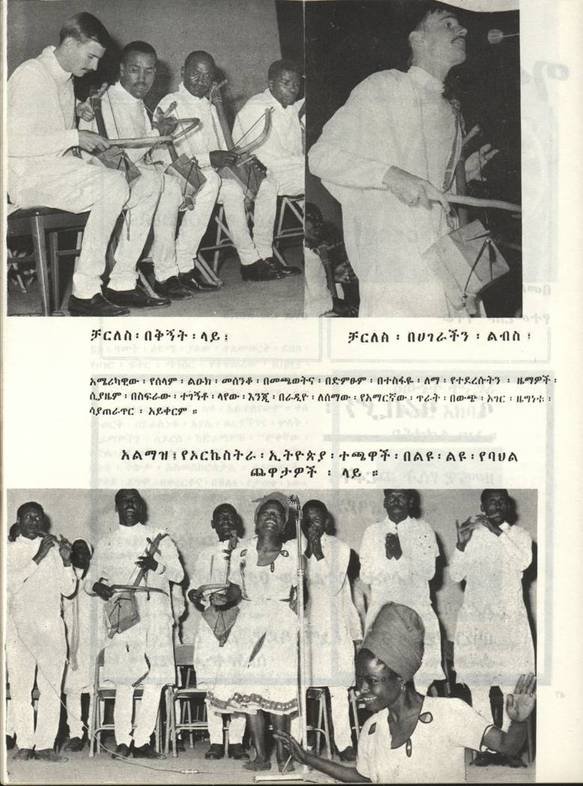
Page 48 of Music Magazine features Charles and Almaz Getachew, the vivacious
singer-dancer from Wolayita, performing with Orchestra Ethiopia.
As I had done for the first time in Utah , once again I was going before an audience to sing in Amharic, but now as the veteran of dozens of television, concert, and wedding performances during the preceding year and a half with Orchestra Ethiopia , a 15-member traditional folkloric troupe. Long gone were the incongruous button-down shirt, striped tie, and slacks of my stateside initiation, replaced by the white cheesecloth cape, long white tunic, and white riding pants that constitute the Ethiopian national dress. Suspended on a leather thong from my left shoulder was a mesenko, which I had spent many laborious hours learning to play.
Even though I dressed in Ethiopian costume, sang Ethiopian songs, and made a fair attempt at performing on an Ethiopian musical instrument, you might well wonder how an amateur mesenko player–an American newcomer to the ancient land where the Peace Corps assigned him to be a teacher of English–could so rapidly have penetrated the ranks of its seasoned professional entertainers and musicians.
The paradoxical explanation is that I owed my improbable career in Ethiopian traditional music directly to the transcendent popularity of Tilahun Gessese.
The most quintessentially Ethiopian of all Ethiopian singers, but simultaneously the undisputed avatar of what was then called “modern music” (“zemenawi muzika”–Western-tinged Ethiopian pop performed on Western musical instruments), Tilahun, and his cohorts in the Imperial Bodyguard (the Army and Police Bands followed close on their heels), seemed in those days to sweep all before them, taking the world of Ethiopian music by storm. Some commentators confidently predicted that Ethiopian traditional music and musical instruments would soon face extinction as a result.
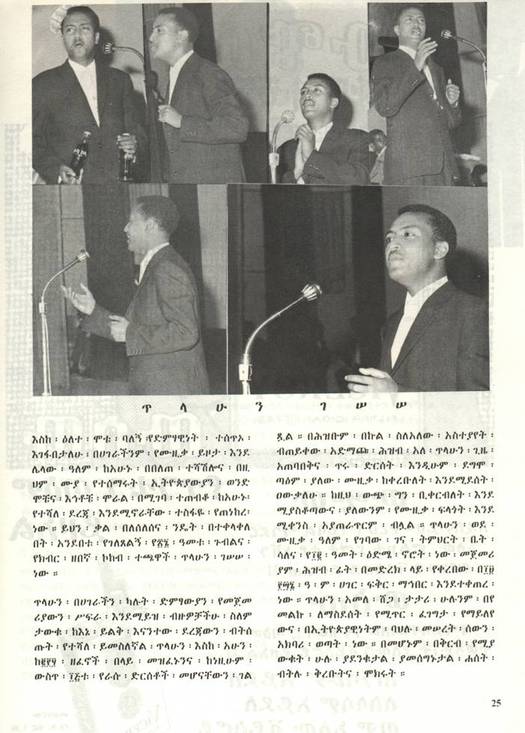
Page 25 of Music Magazine is devoted to Tilahun Gessesse, 26-year-old star
vocalist of the Imperial Bodyguard Orchestra
Orchestra Ethiopia , the group with which I had become associated, was founded under the auspices of the Creative Arts Centre of Haile Selassie I University in 1963 by the Egyptian-American composer and ethnomusicologist Halim El-Dabh, specifically to counter this trend. As Shawul Baminew wrote about Orchestra Ethiopia in Music Magazine, “In order to prevent Ethiopia’s great cultural heritage from being swallowed up by Western civilization and know-how, and with the goal of keeping the country’s native arts alive and to defend against their being swept away in a flood of foreign influences…, one branch of the Creative Arts Centre was dedicated to the preservation of traditional music and given the name ‘Orchestra Ethiopia’…[The Orchestra] would incorporate all the varied instruments characteristic of different Ethiopian ethnic groups, so that these instruments would not molder as displays in a museum, but would play on together in group performance and so be given new life and the chance to expand their musical scope.”
Ato Shawul goes on to say that the then director of the Orchestra, a gifted twenty-year old composer and poet named Tesfaye Lemma, by means of his attractive, innovative compositions and his skilled supervision of the ensemble, had not only brought it a long way toward achieving the goals that had been set for it, but had in the process also won for traditional music an unexpected resurgence in popularity.
Nonetheless, traditional music still faced an uphill fight. Tesfaye told me that the first time Orchestra Ethiopia participated in the New Year’s Festival, before he became director, an impatient audience hooted the musicians off the stage. Things had improved since then, but Tesfaye was still looking for new approaches and special attractions to help Orchestra Ethiopia hold its own against the glitz and glamor of the military bands.
That was where I came in.
Thirty years later, Tesfaye explained in an interview the genesis of his plan for me to join the Orchestra: “It was a new experience for Ethiopians when they saw a foreigner appreciating and performing their music. This brought good attention to the Orchestra, especially in those days. Many people were not conscious of their culture. They didn’t see their music and instruments as valuable. The younger people were more interested in rock music and in learning the guitar and keyboard. When I invited Charles to perform with the Orchestra, it was unusual and they woke up and said, ‘This is good music. An American is playing our music! ‘They came to have more respect for their music as a result.”
At the 1968 New Year’s Festival at the Ambassador Theater, Orchestra Ethiopia finally came into its own. Tesfaye had spent months preparing an all-new program that was greeted with unprecedented enthusiasm by the capacity crowd. The song he wrote for me then–it has been a staple of my repertoire ever since–was called “Mesenko”. The audience liked “Mesenko” so much that I had to sing it twice.
Considered by the organizers to be the least exciting attraction, Orchestra Ethiopia was always first on the bill at the New Year’s Festival, presenting a one-hour program. Next came the Police and Army Bands, each playing for two hours. The grand finale was the Bodyguard’s presentation, with Tilahun’s performance as its climax. As each group finished its job at the Ambassador, it left immediately for the Ras Theater in the mercato, where the New Year’s show was repeated in its entirety at half-price for a young, rough, more boisterous crowd.
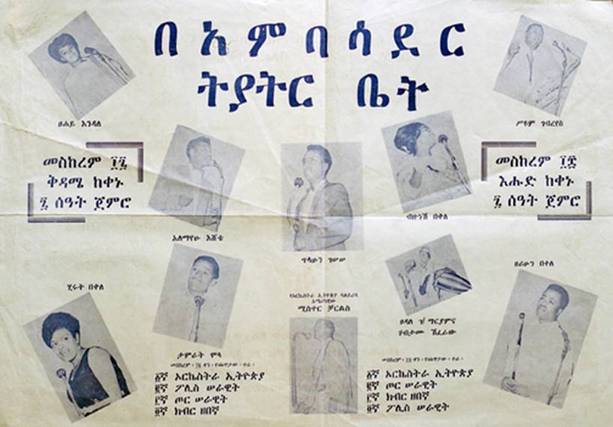
Charles was proud when he saw his photograph positioned directly below Tilahun’s
at the center of this poster advertising a music show in 1968.
I can remember clearly the shock of the transition from the relative decorum of the Ambassador to the rough-and-tumble holiday hubbub of the Ras. We descended from our minibus at twilight into the midst of a disorderly mob through which we had to push our way to the Theater’s back entrance. Once safely inside the dimly lit stage area, we found a scene that seemed to border on chaos, with many people running about and no one apparently in charge. But there was hidden method to this apparent madness; presently we were ushered into the wings and hurriedly prepared to march out on stage. I peeked through a tear in the curtain and felt butterflies in my stomach as I glimpsed a vast, restive multitude standing shoulder-to-shoulder in the darkened, fully packed house.
If a Ras audience found fault with you, their yells, insults, hoots, and catcalls would begin immediately and make it virtually impossible for you to continue your performance. But if you won them over and they liked you, they were equally uninhibited in demonstrating their approbation–nay, love–which you could feel wash over you like a warm wave. At the Ambassador, the rhymes in my new song “Mesenko” had been greeted with polite applause; at the Ras, they elicited roars of delight. The audience began to sway and sing along. A young woman emerged from their midst, climbed a staircase at the side of the stage, and, like a lovely apparition, came dancing toward me. When she kissed me on both cheeks and pasted a 10-birr note to my forehead, the crowd went wild. She was followed by several others who stuffed money into my pockets, the collar of my tunic, under the strap of my mesenko, and even in my shoes–always to uproarious applause.
Orchestra Ethiopia ‘s entire program was very warmly received.
The bus was waiting outside to take us at last to our homes. I unwound by reading some more in Music Magazine, turning now to Shawul Baminew’s appraisal of Tilahun (whose performance that day I was sorry to have missed): “Most of you know already that Tilahun holds the first place among our country’s vocalists. Tilahun is a young man who has a pleasant disposition, is disciplined, strives to please all of his listeners whoever they may be, always has a smile on his face, and, in accordance with Ethiopian custom, respects his fellow man. Because he is like this, everyone who knows Tilahun admires and praises him. If you think I’m lying, approach him. Try him, and you will see.”
Unfortunately, 32 years would pass before I was lucky enough to discover for myself the accuracy of that pronouncement. I was a co-participant with Tilahun in four successive New Year’s festivals, but because Orchestra Ethiopia always appeared at the beginning of the show and the Bodyguard Orchestra at the end, we never met.
However, I did at least get close to Tilahun–in a manner of speaking. Two weeks after Orchestra Ethiopia ‘s success at the Festival of ’68, the entire New Year’s show was staged again by popular demand. A new advertisement posted all over town displayed the photographs of ten star performers. As always, Tilahun occupied the central position. But this time, for once–it was one of the proudest moments of my life–I joined him there.
—-
I look forward to recounting to you in the third and concluding part of my tribute how I eventually did enjoy the good fortune not only to watch on two occasions from the best seat in the house as Tilahun performed, but also to meet him, express to him my admiration, hear his opinion of my singing and mesenko playing, spend some happy times with him, and become his friend.
Charles Sutton
Old Saybrook , Connecticut
June 9, 2009
Remembering Tilahun Gesesse


























Thank you Charlie for your wonderful tribute to the legend of Ethiopian music. I miss Tile. I miss him so much. But he always lives in our memory and in our homes through his music and through remembrances like yours. Thank you for sharing and especially for including the magazine photos! Priceless.
WE Ethiopians lost one of the greatest singers ever in this country. Tile indeed made everyone so happy and touched every human emotions.
No one will forget Tile.
Thank you Mr.Charlie. Your ‘Mesenko’ is the best.
Hi, Charlie thanks for your tribute to our hero Tilahun Gessese. By the way, I was a student in Awassa and was thought by the peace corps in 1996. So may be you had me in school.
Thank you for the memory Mr. Sutton you are right it is a big loss for Ethiopians to loss such a singer like Tilahune. I remember attending one of your shows at the Ambassador Theater. When I think of my childhood in Ethiopia I sometimes think of you and wonder what ever happen to you. I did not remember your name to google you. Did’t you bring the Ethiopian band for the first time to the state in early 70 and performed at Howard University? Could you please post some of your songs you sung with the band. Thanks